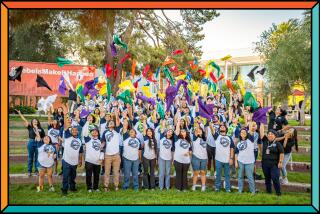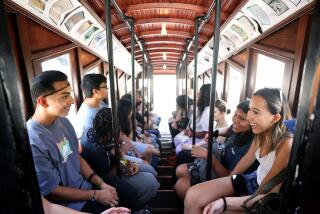No Horatio Alger Tales for Them : Jobs: Youths confront racial and class issues head-on in federally funded employment forum.
- Share via
It’s 1992, and 16-year-old Andre Lamont Samson will tell you: Horatio Alger is dead.
A popular 19th-Century American author, Alger created heroes who helped establish the legend that any poor boy could become a millionaire or president by leading a virtuous life and performing heroic deeds.
It takes more than that now, Andre says.
“Getting ahead means you go begging for work someplace where they don’t want you the way you are,” Andre said. “You get there and change into the Rayon shirt, take off the saggy pants and give them the big Chuck E. Cheese smile. They can put you to work, but you’re out there without an identity. . . . I’d like to learn a little bit more about getting ahead.”
The Palomar High School senior’s take on job prospects was one of the reactions of 700 youths who came to the San Diego Convention Center Monday to meet potential employers and talk about the effect of race and class on how America works.
Participants at the Hire-a-Youth Career & Culture Fair heard speeches, perused some of the 150 job booths and sat in on at least one of 15 discussions on ethnic identity, said Brene Patrick, program director for the sponsoring San Diego Consortium & Private Industry Council. Other supporters included the state Employment Development Department and Hire-a-Youth, a federally and state-funded employment training program for children of low-income families.
“Adults are just beginning to deal with race issues in the workplace,” Patrick said. “And we are trying to heighten awareness of young ones now, so they can identify discrimination and deal with it out in the open.”
The goal is to have young people recognize specific cultural habits and talk about those differences, Patrick said. Organizers hope to give youths a head start on issues that adults in all strata of society are struggling with today.
“We have never come across a group of kids who are not aware that there are differences in culture among them,” Patrick said. “And, instead of pretending problems don’t exist, we are saying, let’s look at them together. Whether or not this happens has to do with how you feel about yourself. You can’t imagine how many children feel it’s a personal problem that they are expected to deal with by themselves.”
In a world of stereotypes, feeling pride because of your differences is a hard emotion to come by, said Ridel Del Rosario, 23, who performed for the cultural component of the fair.
Ethnic performers--mariachis, Irish dancers, an African drum and dance troupe--provided different ways of expression that can be appreciated by all, said Del Rosario, a dancer with a Pilipino performing arts group.
Del Rosario led a performance of the Aray, a formal ballroom dance from the Philippines. The image of dancers resplendent in Barong Tagalogs --formal men’s wear--and women’s flowing ballroom gowns, is in contrast with the stereotype of the gang member that has come to characterize Filipino youth in 15-year-old Reggie de Guzman’s Paradise Hills neighborhood.
“Seems like everyone expects us to go into gangs,” said Reggie, who spends his time after school with friends at the Philippine American Society and Cultural Art Troupe. “It’s hard not to be in a gang, if you have no place else to go.”
The fair was organized with money from a $4.2-million windfall provided for youth jobs through a federal urban aid bill. The jobs aid bill was one of several measures taken by the Bush Administration in response to rioting in Los Angeles this spring.
Fair speakers included City Councilman George Stevens, who eschewed the hard-work-will-get-you-places credo.
“I’ve never told any young person to just work hard and be diligent,” Stevens said. “Given that there is discrimination and ignorance and conflict and out-and-out racism in our world, that’s not realistic. I’ve always said you have to prepare yourself for what’s out there.”










